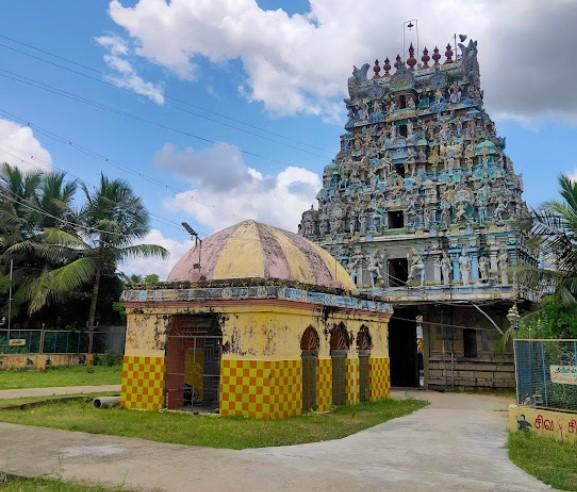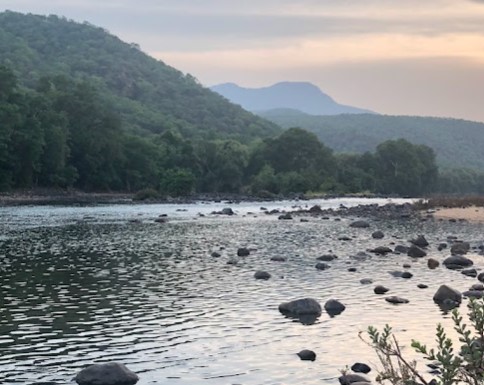The Kayarohanaswami Temple, located in Nagapattinam, Tamil Nadu, is the 199th Thevaram Paadal Petra Shiva Sthalam and the 82nd temple on the southern banks of the Kaveri River in Chozha Nadu. Known historically as Nagai Karonam during the 6th to 7th centuries, this temple is among the 44 moovar paadal petra Shiva temples and is one of the Saptha Vidanga sthalams, where the Shiva Linga is not sculpted using a chisel. The other six Saptha Vidanga temples include Thiruvarur, Thirunallar, Thirumaraikadu, Thirukkarayil, Thiruvaimur, and Thirukolili (Thirukkuvalai).
This temple is particularly significant as it serves as both an avathara and mukthi sthalam of Athipatha Nayanar. The presiding deity, Kayarohana, along with his consort Nilayathakshi, has been revered by Nayanmars such as Appar, Sambandar, and Sundarar. The temple has its roots in the Lakolisa cult, which originated in Gujarat, with its only other Tamil Nadu temple located in Kanchipuram.
The temple features an idol of Thyagaraja made from lapis lazuli. As a Shakti Peetham, it is also popularly referred to as Neelayadakshi Kovil. Special rituals are conducted on Poornima (full moon days), during which a milk pudding (Payasam or kheer) is offered as Naivedhyam. Situated on the seashore, the temple is often regarded as Shiva Rajadhani, or the capital of Shiva’s kingdom, symbolising Shiva’s royal rule over the region.
Notably, this temple is one of the 275 Paadal Petra Sthalams praised in the Thevaram, specifically in hymns sung by Saint Sambandar. While the original Lingam was stolen long ago, it has recently been replaced with a Gomedakam Lingam, continuing the temple's revered legacy.
PURANIC SIGNIFICANCE:
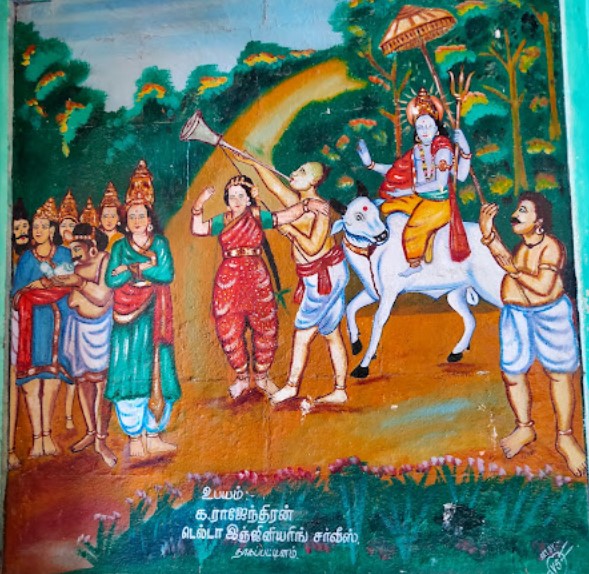
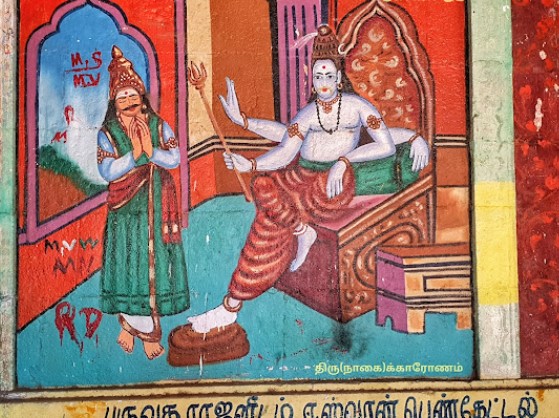
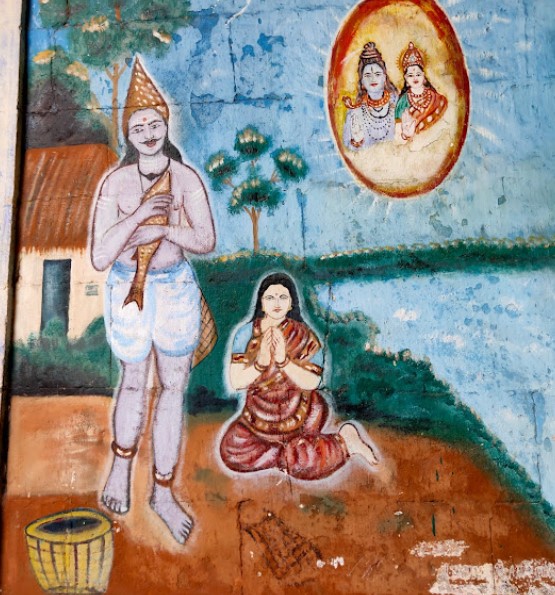
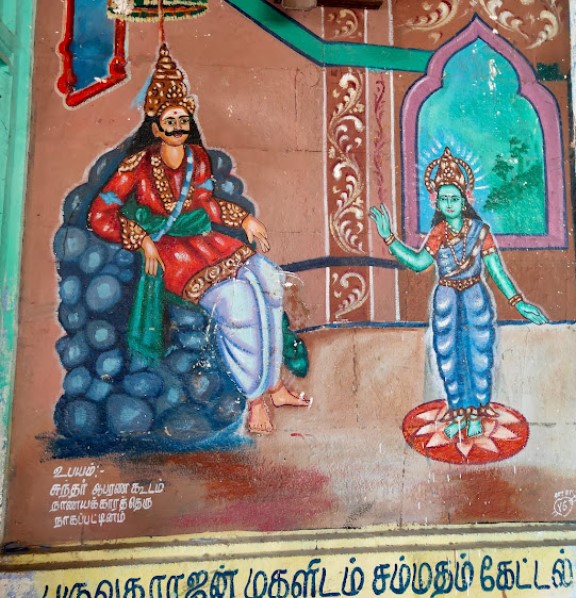
The name, Kayaroganeswarar:
Sage Pundarika was advised by Sage Kanwa to do penance to Lord Shiva for seeking salvation. Shiva gave a darshan and embraced the sage and granted salvation. Usually the soul merges with the divine but as the Lord embraced (Aarohanam) Sage Pundarika along with his body (Tamil: Kayam), Shiva is called Kaya (body) Aarohana (embrace) Easwaran - Lord Kayaroganeswarar.
Nagai Karonam:
Another legend says that the King of Serpents prayed to Shiva and was blessed with a girl child. She was born with three breasts and the serpent king was greatly upset. Shiva assured the king that one breast would disappear when a king from the Surya dynasty visited him. When King Shalisuhan came to this place, the third breast vanished. The Naga king in delight gave his daughter to Shalisuhan in marriage. As the Naga king worshipped here, the place came to be known as Nagai Karonam that became Nagapattinam.
Saptha Vidanga Sthalam:
Emperor Muchukunda got seven Lingas from Indira for the help he had rendered him. These Lingas were small – Vidanga in size. The Emperor installed the Linga in Seven Places called Saptha Vidanga sthalams. This is one such Sthalas with a Linga so beautifully made of Ruby. Hence, the Lord is named Sundara (beautiful) Vidangar.
Irattai Parvai Nandhi:
As Ambica is a virgin, Lord sent Nandhi Deva to be her guard. But Nandhi expressed his wish to be with Lord for ever seeing him. Lord said that he can have his darshan with Ambica. Nandhi in the temple is seen with its neck turned towards Lord with one eye on Ambica and other on the Lord. Hence, the Nandhi is known as Twin View Nandhi (Irattai Parvai in Tamil). Those having vision problems pray to this Nandhi.
Rare Custom of placing Garlands and Clothes used for Lord to corpse:
Generally, temples are closed if a death occurs in a nearby place. In this place, the garlands and the clothes – vastras used for the Lord are placed on the corpse. A fisherman, Adhipathar attained salvation with the grace of Lord Shiva in this place. Remembering this event, as a mark of respect to the community, this practice is followed in this temple. The body is placed before the temple without closing the doors. The garland and the vastras used for the Lord are placed on the body.
Lord procession to seven places instead of going around Mada Veedhis:
During the festival procession, the Lord goes round the Mada Veedhis (Streets) and returns to the temple. But Lord , beginning his procession from this temple, goes to seven places – Poigainallur, Poravacherry, Sikkal, Palur, Vadagudi, Thethi and Nagoor. Maharaja Salija worshipped Lord Shiva and performed puja in these seven places. The present system is to remember this history.
Vishnu accompanies Shiva during Pradosham:
Against the practice of Lord coming in the Vrushab vahanam on Pradosham days, Lord Vishnu too accompanies Lord Shiva in the guise of Mohini. When the milk ocean was churned, Nectar came out and was served by Lord Vishnu to Devas. Devas failed to pray to Lord Shiva who swallowed the Halahala poison to save the world. Realising their folly, they begged the pardon of the Lord. Showing his mercy to them, Lord Shiva danced on Nandhi. This dance took place at the Pradosham time. Lord Vishnu’s Mohini Avatar took place a little before this time. This Vishnu darshan is available to the devotees on Pradosham day only.
Navagrahas facing West – the Lord:
Emperor Dasaratha came to know that Planet Saturn would be splitting the Rohini star causing severe famine in his country. He planned to fight Saturn to prevent him from doing so. Sun God advised Dasaratha to drop his plan but to beg Saturn to change his transit route in public interest. Saturn also admired the earlier plan of the emperor to meet him in war for the sake of his subjects without any selfish motive personally. The planet yielded to the emperor’s wish. Remembering this event, all the planets (Navagrahas) in the temple are facing west-the Lord.
Athipathar attained salvation here:
Fisherman Athipathar was a staunch Shiva devotee. When he went for fishing, he would offer the first to Lord Shiva. At one stage, he was getting only one fish each day but did not break away from his commitment. He offered them to the Lord and returned without any catch. He got a golden fish one day. Though everyone prevented him from throwing it into the sea, Athipathar resolutely stood by his commitment and threw it into the sea.
He was awarded with salvation and a place among the 63 Nayanmars. The event is celebrated on the Ayilyam star day in Aavani month (August-September). Athipathar goes in catamaran when fishermen place two gold fishes in the net as if caught in the net. Lord Shiva will appear on the sea shore. Athipathar performs poojas to Lord Shiva with the golden fishes. Shiva will grace darshan to Athipathar. So goes the festival grandly.
Azhuguni Chithar:
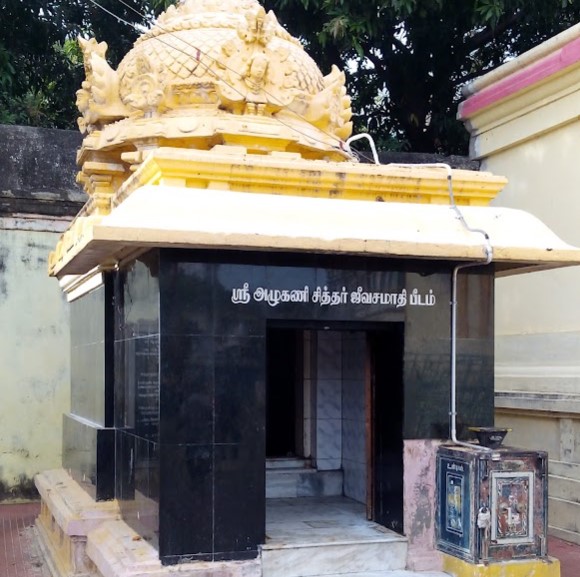
As a child adamantly demanding the mother to get its wish, there was a Siddha in the place called Azhuguni Chithar – crying adamantly for a wish. He used to cry in the shrine of Mother Neelayadakshi demanding salvation. He was the disciple of Gorakka Siddha. He stayed in the temple, cried for his demand. Mother spoke to Lord Shiva of the issue. Lord granted salvation to Azhuguni Chithar. His Jeeva Samadhi is in this temple. Special pujas are performed to Siddha on Vaikasi Visakam day. Also special pujas are performed here offering porridge (Payasam in Tamil) as nivedhana on Poornima – full moon – days.
Praised in Thevaram Hymns:
The temple is greatly praised by the three celebrated saints Sambandar, Appar and Sundarar in their Thevaram hymns. Sundarar received gifts of pearl and diamond chains, a horse and cosmetic things.
Sages worshipped Lord here:
Sages Markandeya, Gauthama, Vasishta, Kashyapa, Pulasthya, Agasthya and Angirasa (Saptha Rishis) had worshipped Lord Shiva in this temple.
Neelayadakshi:
The goddess here is Neelayadakshi. Neelayadakshi means the one with the blue eyes. She is in the form of a pubescent girl, and is believed to be one of the Shakti Peetams. She is also considered to be one among the five most important goddesses, all in different stages of life. These are - Visalakshi (Kashi - Child), Kamakshi (Kanchi - young girl), Neelayadakshi (Nagai - pubescent), Kamalambigai (Thiruvarur - young woman) and Meenakshi (Madurai - married woman).
History
The temple has been in existence from the 6th century AD and praised by the Nayanmars Appar, Sambandar and Sundarar. The temple has been constructed by the Lakolisa cult which originated in Gujarat. The idol of Thyagaraja in the temple is made of lapis lazuli. Karona is a corruption of Kaya-rohana and the temple is the twin of Kayarohana temple in Gujarat. Karonam might also have been derived from other origins such as “Kar Onam” and Lord Vishnu has been referred as “Onathan”. The temple has been rebuilt by the Pallavas and Cholas. This temple is one of the sapthavitanga Sthalams. It is also known as the temple of Neelayadakshi.
ADMINISTRATION:
The Kayarohanaswami Temple is typically administered under the Hindu temple administration system, which may vary by region.
